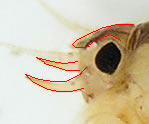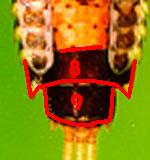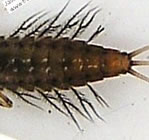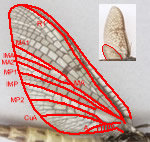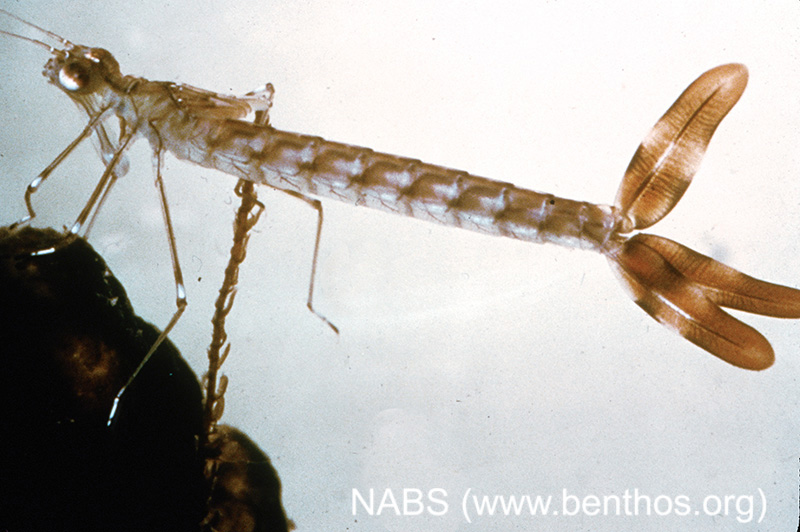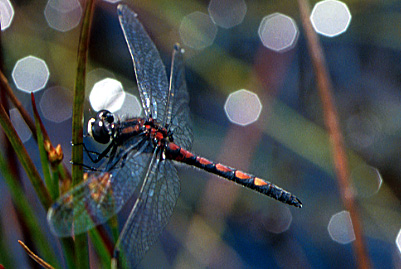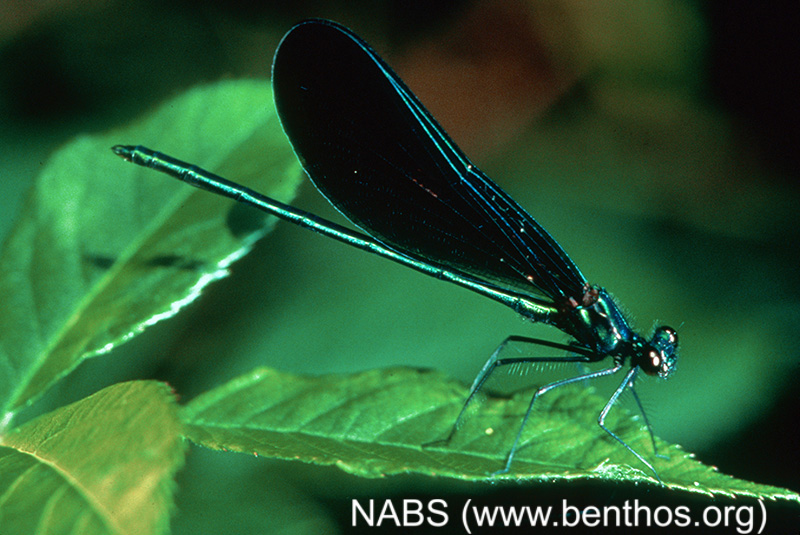Field Guide - Aquatic Insects of the Great Lakes
Contents:
- Nymphs and Larvae
- Adults
-
Ephemeroptera - Mayflies
-
Key to Ephemeroptera Nymphs
- Ephemeroptera Nymphs - Key to the 9 Great Lakes Families
- Ephemeridae nymphs - Key to the 3 Great Lakes Genera
- Ephemerellidae nymphs - Key to the 2 Great Lakes Genera
- Heptageniidae nymphs - Key to the 3 Great Lakes Genera
- Baetidae nymphs - Key to the 5 Great Lakes Genera
- Leptophlebidae nymphs - Key to the 2 Great Lakes Genera
- Key to Adult (Imago/Subimago) Ephemeroptera
-
Key to Ephemeroptera Nymphs
- Keys to Odonata Nymphs
This Field Guide is based on information from:
Lehmkuhl, D.M. 1979. how to know the aquatic insects. The Pictured Key Nature Series. Wm C. Brown Co. Dubuque, Iowa.
American Museum of Natural History Key to Insect Orders. https://www.amnh.org/learn/biodiversity_counts/ident_help/Text_Keys/arthropod_keyA.htm Accessed 2008.
Valley City State University. Digital Key to Aquatic Insects of North Dakota. http://www.waterbugkey.vcsu.edu/php/mainkey.php?id=Order3 Accessed 2008.
NOAA. Great Lakes Aquatic Nonindigenous Species Information System (GLANSIS). https://www.glerl.noaa.gov/glansis/ Accessed 2019.
Additional guides and keys:
Cudmore-Vokey, B., Crossman, E.J. 2000. Checklists of the fish fauna of the Laurentian Great Lakes and their connecting channels. Can. Ms. Rep. Fish. Aquat. Sci., no. 2550.
Roth, B.M., Mandrak, N.E., Hrabik, T.H., Sass, G.G., Peters, J. 2012. Fishes and decapod crustaceans of the Great Lakes Basin. In Taylor, W.W., Lynch, A. (Eds.), Great Lakes Policy and Management: A Binational Perspective, Michigan State University Press, East Lansing, Michigan, pp. 105–136.
Balcer, M.D., Korda, N.L., Dodson, S.I. 1984. Zooplankton of the Great Lakes: A guide to the identification and ecology of the common Crustacean species. University of Wisconsin Press, Madison Wisconsin. Balcer part 1, Balcer part 2, Balcer part 3
Grothe, D.W., Grothe, D.R. 1977. An Illustrated Key to the Planktonic Rotifers of the Laurentian Great Lakes. U.S. EPA, Great Lakes National Program Office, Chicago, Illinois.
Hudson, P.L., Lesko, L.T., 2003. Free-living and Parasitic Copepods of the Laurentian Great Lakes: Keys and Details on Individual Species. Available at https://www.glsc.usgs.gov/greatlakescopepods/MainMenu.php.
Robertson, A., Gannon, J. E. 1981. Annotated checklist of the free-living copepods of the Great Lakes. J. Great Lakes Res. 7, 382–393.
Hiltunen, J.K., Klemm, D.J. 1980. A guide to the Naididae (Annelida, Clitellata, Oligochaeta) of North America. Report EPA-600/4-80-0, U.S. EPA, Environmental Monitoring and Support Laboratory, Cincinnati, Ohio.
Hoffman, G. L. 1999. Parasites of North American freshwater fishes. Cornell University Press, Ithaca, New York.
Mackie, G.L., White, D.S., Zdeba, T.W. 1980. A guide to freshwater mollusks of the Laurentian Great Lakes, with special emphasis on the genus Pisidium. Report EPA/600/3-80-068, U.S. EPA, Environmental Research Laboratory, Duluth, Minnesota.
Some Ephemeroptera nymphs and Diptera larvae are common in the deep profundal benthic zones of the Great Lakes - other orders of aquatic insect larvae are restricted to littoral or tributary benthos, nearshore surface waters (e.g., water striders), or are parasitic on other Great Lakes waterlife (e.g., Lepidoptera and braconid wasps). Some Coleoptera and Hemiptera remain fully aquatic as adults (usually littoral) - other orders of aquatic insects have winged adults and are usually found floating on the water surface, associated with emergent macrophytes (e.g., wetlands) or in nearshore terrestrial habitats.
Nymphs and Larvae
Note on juvenile stages - Pupae are inactive stages (e.g., hard case, translucent case or cocoon). Larvae and nymphs are both active stages. Nymphs have rudimentary wings (or wing buds) and usually have jointed legs (usually 3 pair) similar to adults. Larvae lack rudimentary wings and usually lack legs or are limited to prolegs or projections (usually other than 3 pairs).
|
|
|
|
|
|
|
|
|
|
|
|
|
|
|
Adults
|
Adult - 2-3 threadlike tails |
|
|
|
 Plecoptera (stoneflies) Adult - wings held flat and parallel to the body with hindwings fanfolded beneath the shorter forewings when at rest |
|
|
|
 Coleoptera (beetles) Adult - forewings hardened to a protective covering meeting in a straight line down the back |
|
|
|
Ephemeroptera - Mayflies
Some Ephemeroptera nymphs are common in the deep profundal benthic zones of the
Great Lakes - others are restricted to littoral or tributary benthos. Winged adults
are usually found floating on the water surface, associated with emergent macrophytes
(e.g., wetlands) or in nearshore terrestrial habitats. Ephemeroptera live most of their
lives as nymphs with a very brief adult stage (mate and die). Mayflies are unique among
insects in that they molt once as an 'adult' - thus having 2 winged stages. The
subimago or dun is a shortlived stage usually at the water surface. The imago or
spinner is the final form which participates in the mating flight. Adults usually lack
a mouth and so are incapable of eating (or biting) and generally live less than 3 days
after emergence. Ephemeroptera exhibit swarming behavior in which emergence
(transformation of aquatic nymphs to flying adults) is strongly coincident (all the
nymphs of the right age in an area transform within days of each other). Both nymphs
and emergent adults are an important source of food for fish.
Fishermonk's Short Key to Mayfly Genera was consulted in the development of the Great
Lakes keys on this page.
Key to Ephemeroptera Nymphs
Some Odonata (damselfly) nymphs are easily confused with Ephemeroptera (mayfly) nymphs.
Ephemeroptera Nymphs - Key to the 9 Great Lakes Families
|
|
|
|
|
|
|
|
|
|
|
|
Ephemeridae nymphs - Key to the 3 Great Lakes Genera
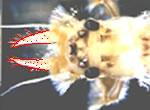
Ephoron |
|
|
||
Ephemerellidae nymphs - Key to the 2 Great Lakes Genera
|
|
|
|||
Heptageniidae nymphs - Key to the 3 Great Lakes Genera
|
|
|
|
||
Baetidae nymphs - Key to the 5 Great Lakes Genera
|
|
|
|
|
Pseudocloeon |
Leptophlebidae nymphs - Key to the 2 Great Lakes Genera
|
|
|
|||
Key to Adult (Imago/Subimago) Ephemeroptera
Ephemeroptera Adults - Key to Great Lakes Families
Typical keys to the adult (imago/subimago) forms of mayflies rely heavily on patterns of veins in the forewings for identification. A good hand lens is a necessity for proper identification.
|
Baetiscidae Tail: 2-3, 3rd (middle) tail is very short or absent Wings: Hindwings variable, may be reduced or absent, if present almost circular in shape. Venation: Vein MP2 not bent, not parallel with CuA near wing base, from vein MP1; vein MP2 only may diverge from MP1. Cubital intercalaries absent with vein A1 terminating in outer margin of wings. |
Leptohyphidae Body: <4mm. Bodies have a heavy thorax Tails: 3 Wings: hindwings absent. Forewings longer in relation to width than Caenidae Venation: Vein MA forming a more or less symmetrical fork, and veins MP2 and IMP extend less than three-fourths of distance to base of vein MP. |
Caenidae Body: <4mm. Robust thorax, small abdomen Tails: 3 Wings: hindwings absent. Forewings shorter in relation to width than Leptohyphidae Venation: MA2 attached basally by a crossvein, and veins MP2 and IMP almost as long as vein MP extending nearly to base. |
|
Color: Abdomen of most species with striking dark pattern - except Ephoron which is yellow shaded with tan. Body: 12-40mm. Tails: 2-3 Wing: Hindwings present. Costal angulation of hindwings usually rounded, but may be nearly acute or at right angles Venation: Base of vein MP2 sharply bent near the wing base towards CuA and sometimes fused at base with CuA. Vein A1 forked near margin and outer margin with dense network of reticulate veinlets (Ephoron) OR vein A1 unforked, attached to hind margin by three or more veinlets. |
Ephemerellidae Body: 4-15mm. Tails: 3 Wings: Hind wings usually large, with a pronounced angle on the fore margin. Costal projection shorter than wing width. Venation: Vein MP2 not bent, not parallel with CuA near wing base; vein MP2 only may diverge from MP1. One or two long intercalary veins between MP2 and CuA. Cubital intercalaries variable, but not as a series of veinlets or attaching vein CuA to hind margin. Short, basally detached marginal intercalaries present between veins along entire outer margin of wings. |
Heptageniidae Body:4-20mm. Tails: 2 Wings:Hindwings large Venation: Vein MP2 not bent, not parallel with CuA near wing base; vein MP2 only may diverge from MP1. MA2 and MP2 attached basally. 2 pairs of cubital intercalaries present with vein A1 terminating in hind margin of wings. |
|
Baetidae Body: 4-20mm. Abdominal segments ~ equal. Tails: 2 Wings: Hind wings <1/2 long as forewings or absent. Costal projection of hindwings acute. Venation: Vein MP2 not bent, not parallel with CuA near wing base. Veins MA2 and MP2 may be detached basally from their respective sterns. Cubital intercalaries (A) consist of a series of veinlets, often forking or sinuate, attaching vein CuA to hind margin OR (B) with vein A1 terminating in hind margin of wings OR (C) absent. Short, basally detached, single or double marginal intercalaries may be present in each interspace. |
Leptophlebiidae Body: 4-12mm. Tails: 3 Wings: Hind wings present and usually relatively large but without a pronounced angle on the fore margin. Costal projection shorter than wing width. Venation: Vein MP2 not bent, not parallel with CuA near wing base; vein MP2 only may diverge from MP1. 1-2 pair of cubital intercalaries, but not attaching vein CuA to hind margin nor two pairs in which the anterior pair is long and the posterior pair very short nor Vein A-I attached to hind margin. True basally detached marginal intercalaries usually absent along entire outer margin of wings. |
Oligoneuridae Body: 9-17mm, dark Forewing venation greatly reduced, apparently only three or four longitudinal veins behind R1. |
Ephemeridae Adults - Key to Great Lakes Genera
|
11-13mm, legs feeble, mostly non-functional. Wings often somewhat translucent and colorless or with gray or purplish gray shading. |
15-20mm, legs functional; spotted wings; 3 tails of equal length |
30-40mm, legs functional; wings hyaline without spots, 2 tails (or middle very short), body yellow-light brown and patterned. |
||
Ephemerellidae Adults - Key to Great Lakes Genera
|
3 tails of equal length |
Eurylophella NA |
|||
Heptageniidae Adults - Key to Great Lakes Genera
|
4-12mm, Wings may have crossveins below bullae clouded, but not dark. Basal crossveins between R1 and R2 rarely margined. Penes not L-shaped |
6-20mm, Wings may have crossveins below bullae clouded, but
not dark. Basal crossveins between R1 and R2 rarely margined.
Penes more or less L-shaped |
~13mm, Wings with 2-3 crossveins below bullae between veins R1 and R2 connected or nearly connected by dark pigmentation, rarely only a dark spot. Basal crossveins between R1 and R2 dark margined. |
||
Baetidae Adults - Key to Great Lakes Genera
|
9mm. Cubital intercalaries of forewing consist of a series of veinlets, often forking or sinuate, attaching vein CuA to hind margin. |
4-10mm. Both fore and hind wings with few crossveins. Marginal veinlets of forewing in pairs. |
Hindwings minute with an obtuse costal angulation. Both fore and hind wings with numerous crossveins. Body appears freckled. |
Hindwings small w/hooked costal angulation. Both fore and hind wings with few crossveins; Marginal veinlets of forewing single. |
Pseudocloeon 4-6mm. No hindwings |
Leptophlebidae Adults - Key to Great Lakes Genera
|
10-12 mm; body robust; the middle tail is shorter and thinner than the outer ones. |
4-8 mm; body slender; 3 tails about equal in length and thickness. Brown or pale in color. |
|||
Keys to Odonata Nymphs
Note on juvenile stages - Nymphs are active stages. Nymphs have rudimentary wings (or wing buds) and usually have jointed legs (usually 3 pair) similar to adults. Nymphs are most easily identified to species when individuals are mature (late instar).
Odonata Nymphs - Key to the Suborders
|
Gills in the posterior digestive tract. Suborder Anisoptera |
Gills consist of 3 flat external plates at the posterior end. Suborder Zygoptera |
Odonata Adults - Key to the Suborders
|
Stout build, Strong sustained flight. Wings held flat when perched. Anisoptera |
Slight build. Weak, fluttery flight. Wings held over back when perched (except spreadwings) Zygoptera |

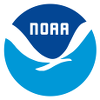

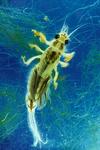
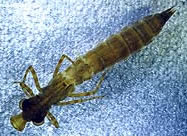


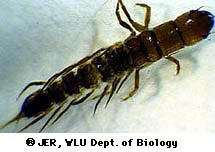


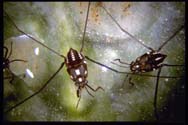
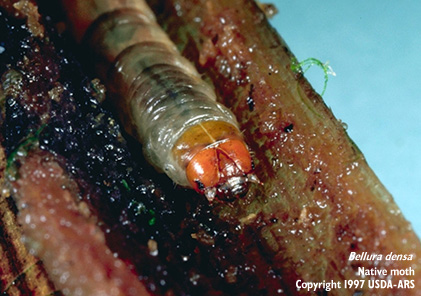
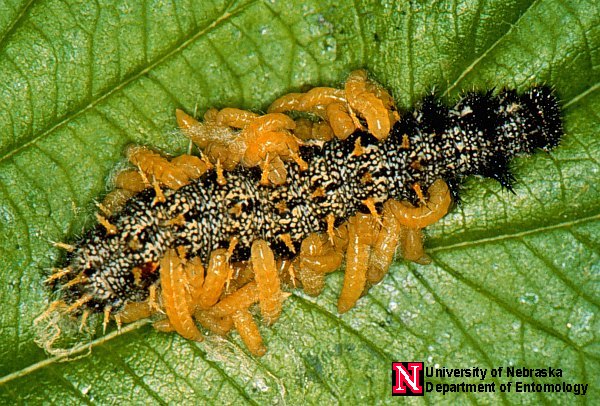
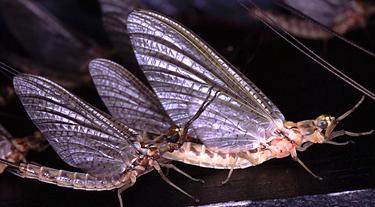
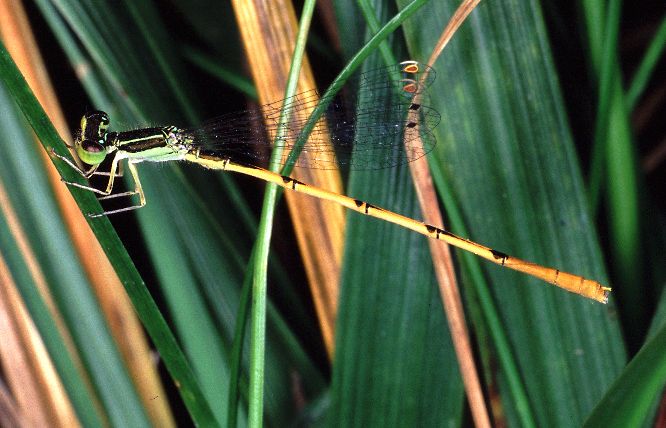
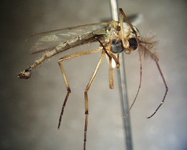
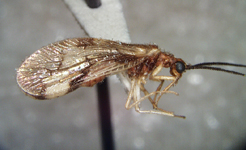
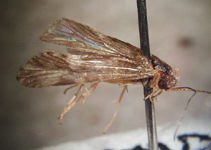

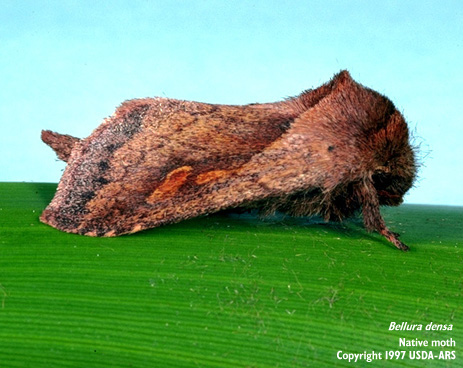
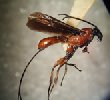





 Heptageniidae
Heptageniidae

